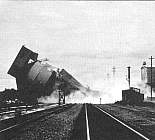Two familiar sights as the diesels have taken over on the Southern. Strings of out moded steam power have been dragged away to scrap yards and coaling stations have been dynamited. |
 |
(Newspapers throughout the country displayed great interest in the fact that the Southern Railway System had completed its dieselization program. News columns and editorial pages commented favorably upon the progress it represented as our railway became the largest system to accomplish such a major modernization program.)
(They were interested, too, in the final steam run. The following is part of the story written by Cha tanooga Times' reporter R. F. Siemanowski who made the trip.)
Her crew, notified only the evening before of the nature of their run, consisted of C. F. Case, Sr ., engineer; J. E. Griffey, fireman; H. H. Houghton, conductor; C. D. McMahan, Jr., flagman; and A. R. Clevenger, head brakeman; W. C. Johnson, train- master, and Road Foreman C. H. Delaney also made the trip.
By 10:30, churning under the impatience of a 225- pound head of steam boiled up within her by the orange flames that licked her sides, 6330 screamed out a "highball" and tore along the tracks skirting the Emory River. .
Two familiar sights as the diesels have taken over on the Southern. Strings of out moded steam power have been dragged away to scrap yards and coaling stations have been dynamited. |
 |
Belching cinders and banks of black smoke that obliterated the lines of poplars marking her course, she ripped along' the tracks that carved into red dirt declivities, chopped holes in mountain stone embankments, climbed small hills and skirted big ones.
"This is the last time," Case said smilingly, leaning with heavy arm on the baleful whistle that sent frightened cows scurrying away from the tracks. And then Griffey tried the whistle. And then Clevenger. And then Delaney.
The important thing about this "jack" -as he called her-was that she could go places. "In her day she could make 90 an hour," Case approvingly remarked as the engine strained, churned, clanked, wobbled drunkenly on it3 way.
But even that day, even as a scheduled run, 6330 was not to have much of an opportunity to prove there was a dance in the old girl yet. Twice during the course of the run she was shunted to a siding to allow a diesel freight and the streamlined Royal Palm to take the main track. Once, nonetheless, the yellow light showed above the red, indicating that some other unit had been sided to allow her to keep her course. But that was only a small work crew riding aboard a single-unit diesel engine. It wasn't another train at all.
Coaling stations have been dynamited. The diesels are now in full charge. |
 |
At Hixson, officials of the company boarded the engine for the last leg of the journey. A short while later, with a fanfare of whistle blasts that roused flocks of night hawks nested in the tall weeds lining the yards, 6330 drew abreast her historic companion at the Third Street Bridge.
After greeting ceremonies, 6330 was shunted to ash pit and the bottom folded out of her boiler, the orange-red steaming coals dumped on the ground. She had come to the very end of the line. Her bell will be given to a church; her whistle to a factory. That is all that will be saved.
(Ties' thanks to the Chattanooga Times and to Mr . Siemanowski for permission to reprint this story. Its thanks, too, to J. C. McLarn, chief clerk to superintendent of motive power, Charlotte.)